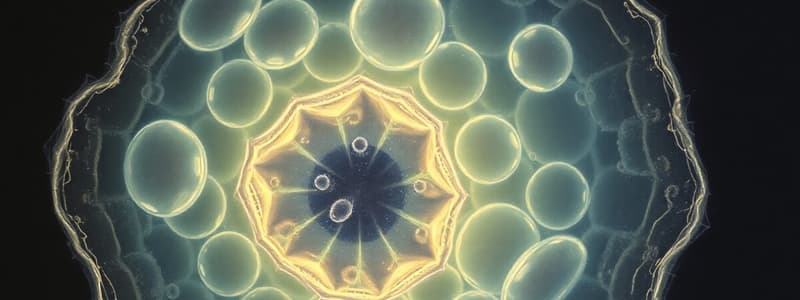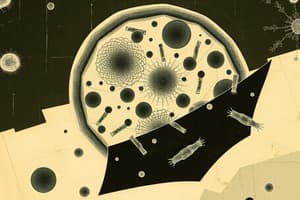Podcast
Questions and Answers
Aké sú hlavné časti, ktoré tvoria štruktúru bunky?
Aké sú hlavné časti, ktoré tvoria štruktúru bunky?
- Štyri hlavné súčasti: bunková stena, cytoplazma, jadro a biomembrána (correct)
- Cytoplazmatická membrána, slizové puzdro, plazmidy, tylakoidy
- Bunková stena, cytoplazma, jadro, ribozómy
- Súčasti, ktoré sú nevyhnutné pre pohyb bunky, jej rozdelenie a ochranu
Ktorá z nasledujúcich buniek je prokaryotická?
Ktorá z nasledujúcich buniek je prokaryotická?
- Bunka baktérie (correct)
- Bunka živočícha
- Bunka huby
- Bunka riasa
Čo plní ochrannú funkciu v prokaryotickej bunke?
Čo plní ochrannú funkciu v prokaryotickej bunke?
- Bunková stena (correct)
- Plazmidy
- Ribozómy
- Cytoplazmatická membrána
Ktorá časť eukaryotickej bunky je zodpovedná za rozdelenie vnútorného priestoru?
Ktorá časť eukaryotickej bunky je zodpovedná za rozdelenie vnútorného priestoru?
Ako sa nazývajú malé kruhové DNA v prokaryotických bunkách?
Ako sa nazývajú malé kruhové DNA v prokaryotických bunkách?
Aká je hlavná funkcia ribozómov v prokaryotických bunkách?
Aká je hlavná funkcia ribozómov v prokaryotických bunkách?
Aké sú hlavné zloženie biomembrány eukaryotickej bunky?
Aké sú hlavné zloženie biomembrány eukaryotickej bunky?
Ktorá z nasledujúcich funkcií je zabezpečená cytoplazmatickou membránou?
Ktorá z nasledujúcich funkcií je zabezpečená cytoplazmatickou membránou?
Aká je hlavná funkcia endoplazmatického retikula v bunke?
Aká je hlavná funkcia endoplazmatického retikula v bunke?
Ktoré z nasledujúcich tvrdení je správne o Golgiho aparáte?
Ktoré z nasledujúcich tvrdení je správne o Golgiho aparáte?
Aká je funkcia mitochondrií v bunkách?
Aká je funkcia mitochondrií v bunkách?
Ktorá funkcia je spojená s integrálnymi bielkovinami v biomembráne?
Ktorá funkcia je spojená s integrálnymi bielkovinami v biomembráne?
Čo obsahujú chloroplasty, ktoré im umožňuje fotosyntézu?
Čo obsahujú chloroplasty, ktoré im umožňuje fotosyntézu?
Ktorý z týchto plastidov je najviac zastúpený vo farebných častiach rastlinných pletív?
Ktorý z týchto plastidov je najviac zastúpený vo farebných častiach rastlinných pletív?
Akú úlohu plní cytoplazmatická membrána?
Akú úlohu plní cytoplazmatická membrána?
Akú štruktúru vytvára vnútorná membrána mitochondrií?
Akú štruktúru vytvára vnútorná membrána mitochondrií?
Čo je bunková stena a kde sa nachádza?
Čo je bunková stena a kde sa nachádza?
Čo je hlavnou funkciou leukoplastov v rastlinách?
Čo je hlavnou funkciou leukoplastov v rastlinách?
Ktorá z nasledujúcich štruktúr nie je súčasťou jadra?
Ktorá z nasledujúcich štruktúr nie je súčasťou jadra?
Akú funkciu majú plazmodezmy vo rastlinných bunkách?
Akú funkciu majú plazmodezmy vo rastlinných bunkách?
Ktoré z nasledujúcich štruktúr nie je súčasťou chloroplastu?
Ktoré z nasledujúcich štruktúr nie je súčasťou chloroplastu?
Z čoho je tvorená bunková stena rastlinných buniek?
Z čoho je tvorená bunková stena rastlinných buniek?
Aká je primárna úloha jadra v eukaryotickej bunke?
Aká je primárna úloha jadra v eukaryotickej bunke?
Aký je obsah jadra a čo sa formuje z karyoplazmy?
Aký je obsah jadra a čo sa formuje z karyoplazmy?
Kde sú prítomné vakuoly?
Kde sú prítomné vakuoly?
Akú funkciu majú lyzozómy?
Akú funkciu majú lyzozómy?
Čo je hlavná funkcia cytoskeletu?
Čo je hlavná funkcia cytoskeletu?
Kde sa nachádzajú ribozómy?
Kde sa nachádzajú ribozómy?
Aké enzýmy obsahujú lyzozómy?
Aké enzýmy obsahujú lyzozómy?
Čo zabezpečuje mitotický aparát počas bunkového delenia?
Čo zabezpečuje mitotický aparát počas bunkového delenia?
Akú úlohu plnia mikrofilamenty v cytoskeletoch?
Akú úlohu plnia mikrofilamenty v cytoskeletoch?
Čo charakterizuje chromozómy počas mitózy?
Čo charakterizuje chromozómy počas mitózy?
Flashcards
Prokaryotic Cell
Prokaryotic Cell
A type of cell that does not have a nucleus or other membrane-bound organelles, smaller in size compared to eukaryotes.
Eukaryotic Cell
Eukaryotic Cell
More complex cell type with a nucleus and membrane-bound organelles; found in animal, plant, fungi, and protist cells.
Cell Wall
Cell Wall
A rigid layer outside the cell membrane that provides structural support and protection.
Cell Membrane
Cell Membrane
Signup and view all the flashcards
Nucleoid (Prokaryote)
Nucleoid (Prokaryote)
Signup and view all the flashcards
Biomembrane
Biomembrane
Signup and view all the flashcards
Phospholipid Bilayer
Phospholipid Bilayer
Signup and view all the flashcards
Ribosomes
Ribosomes
Signup and view all the flashcards
Formy function
Formy function
Signup and view all the flashcards
Endoplasmic Reticulum function
Endoplasmic Reticulum function
Signup and view all the flashcards
Golgi Apparatus function
Golgi Apparatus function
Signup and view all the flashcards
Mitochondria structure
Mitochondria structure
Signup and view all the flashcards
Mitochondria function
Mitochondria function
Signup and view all the flashcards
Plastid types
Plastid types
Signup and view all the flashcards
Chloroplast structure
Chloroplast structure
Signup and view all the flashcards
Golgi Apparatus parts
Golgi Apparatus parts
Signup and view all the flashcards
Cell Wall
Cell Wall
Signup and view all the flashcards
Cytoplasmic Membrane/Plasma Membrane
Cytoplasmic Membrane/Plasma Membrane
Signup and view all the flashcards
Integral Proteins
Integral Proteins
Signup and view all the flashcards
Peripheral Proteins
Peripheral Proteins
Signup and view all the flashcards
Nucleus
Nucleus
Signup and view all the flashcards
Nuclear Envelope
Nuclear Envelope
Signup and view all the flashcards
Nuclear Pores
Nuclear Pores
Signup and view all the flashcards
Eukaryotic Cell
Eukaryotic Cell
Signup and view all the flashcards
Vacuoles
Vacuoles
Signup and view all the flashcards
Lysosomes
Lysosomes
Signup and view all the flashcards
Ribosomes
Ribosomes
Signup and view all the flashcards
Cytoskeleton
Cytoskeleton
Signup and view all the flashcards
Chromosomes
Chromosomes
Signup and view all the flashcards
Mitotic Apparatus
Mitotic Apparatus
Signup and view all the flashcards
Flagella
Flagella
Signup and view all the flashcards
Cytoskeleton Components
Cytoskeleton Components
Signup and view all the flashcards
Study Notes
Bunková štruktúra
- Bunka je základnou stavebnou a funkčnou jednotkou živých organizmov. Jej tvar, veľkosť a vnútorné usporiadanie sú dedične a funkčne podmienené. Väčšina buniek má mikroskopické rozmery (10-100 µm), ale niektoré ich presahujú (např. baktérie, vajíčko vtákov).
- Podľa evolučného prispôsobenia sa bunky rozdeľujú na prokaryotické a eukaryotické. Všetky bunky majú základné štyri zložky.
Prokaryotická bunka
- Je rádovo menšia a jednoduchšia ako eukaryotická bunka. Prokaryotické bunky majú len baktérie, sinice a archeóny. Ich tvar je zvyčajne guľovitý alebo tyčinkový.
- Bunkové povrchy: Bunková stena plní ochrannú funkciu a nachádza sa na povrchu niektorých buniek. Na povrchu sa môžu nachádzať aj bičíky a riasinky, ktoré umožňujú pohyb. Slizové puzdro zvyšuje ochranu bunky. Cytoplazmatická membrána ohraničuje vnútorný priestor bunky od okolia. Riadi príjem a výdaj látok, plní úlohy dýchania a fotosyntézy.
- Cytoplazma: Vnútorný priestor nie je členený na štruktúry pomocou biomembrán.
- Bunkové organely: Jadro nahrádza nukleoid, ktorý neobsahuje membránu. Plazmidy sú malé kruhové DNA molekuly s doplnkovými génmi pre baktérie. Ribozómy sú zodpovedné za syntézu bielkovín. Bunkové inklúzie majú rovnakú funkciu ako u eukaryotických buniek.
Eukaryotická bunka
- Túto bunku poznáme aj ako zložitejšiu bunku.
- Bunkové povrchy: Bunková stena sa nachádza len u rastlín a húb. Tvorená je z celulózy alebo chitínu. Niektoré rastliny majú bunkovú stenu preniknutú anorganickými látkami. Živočíšne bunky nemajú bunkovú stenu. Funkcia bunkovej steny je predovšetkým ochrana a podpora bunky. Cytoplazmatická membrána ohraničuje bunku od okolia a reguluje molekulárny transport.
- Cytoplazma: Obsahuje rozličné štruktúry, ktoré sú rozdelené biomembránami na funkčné oblasti.
- Bunkové organely: Jadro je kontrolným centrom bunky a obsahuje genetickú informáciu v chromozómoch. Jadro je obklopené jadrovou membránou s jadrovými pórmi. Jadro obsahuje aj jadierko (nukleolus), ktoré je zodpovedné za produkciu ribozómov. Endoplazmatické retikulum (ER) – sú to sploštené vaky a kanály, ktoré zabezpečujú produkciu proteínov a lipidů. Golgiho aparát spracováva, balí a transportuje proteíny a iné molekuly. Mitochondrie sú energetickými centrami bunky. Plastidy ako chloroplasty sú zodpovedné za fotosyntézu. Vakuoly ukladajú zásobné látky a pomáhajú udržiavať vnútorný tlak bunky (turgo). Lyzozómy obsahujú enzýmy na trávenie. Ribozómy syntetizujú bielkoviny. Cytoskelet tvorí kostru bunky a umožňuje pohyb bunky a organel. Neživé zložky ako vakuoly umožňujú ukladanie zásob a odpadových látok.
Studying That Suits You
Use AI to generate personalized quizzes and flashcards to suit your learning preferences.
Related Documents
Description
Tento kvíz sa zaoberá bunkovou štruktúrou a základnými charakteristikami prokaryotických buniek. Zistite, ako sa bunky rozdeľujú a aké funkcie plnia rôzne zložky buniek. Prehlbte svoje znalosti o biologickej organizácii živých organizmov.




